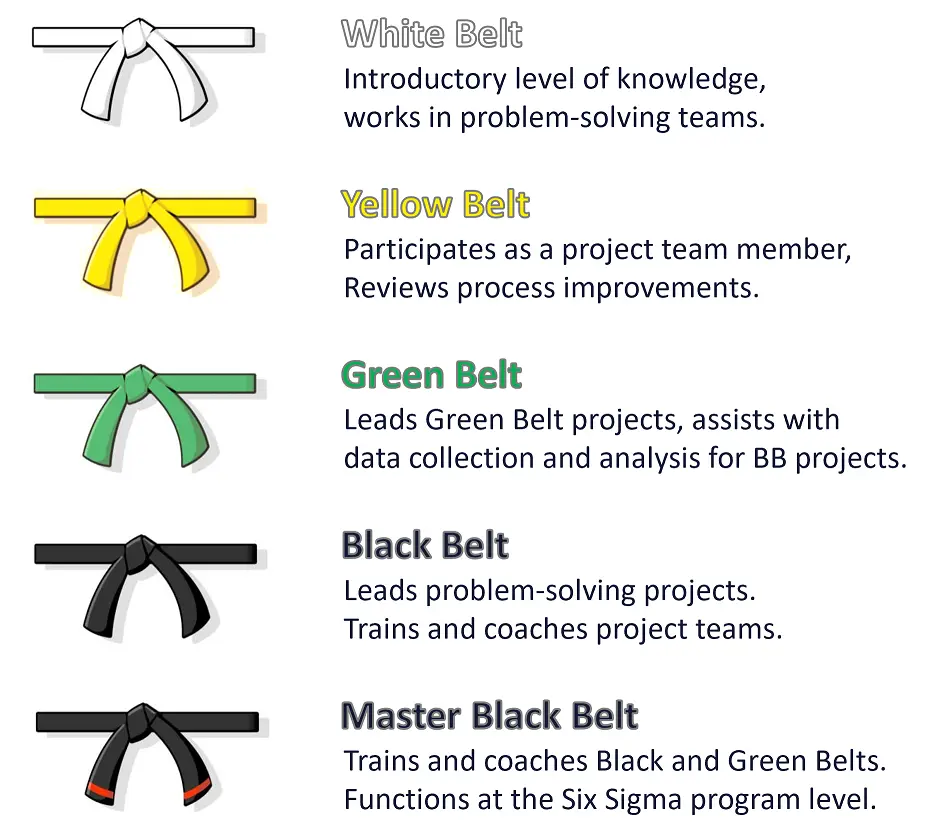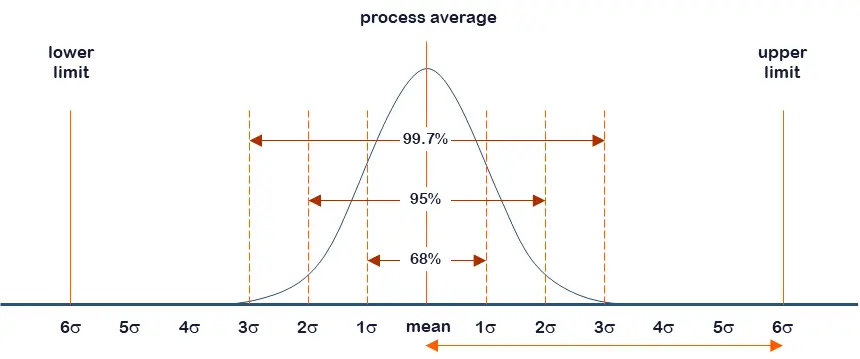1. Introduction
Lean Six Sigma, a powerful amalgamation of Lean methodologies and Six Sigma principles, has become a cornerstone in the pursuit of excellence in process improvement. In this short introduction, we look at the origins, fundamental principles, application across diverse industries, and the underlying philosophy of statistical data analysis that defines Lean Six Sigma. We also cover ability to integrate efficiency and quality, and the principles of waste reduction from Lean methodologies.
2. Origins of Lean Six Sigma
Lean
Just after WW2, Kiichiro Toyoda, Taiichi Ohno, and others at Toyota revisited Ford’s continuous production system, which was highly efficient but came at the cost of a stifling inflexibility, and invented the Toyota Production System. This system in essence shifted the manufacturing engineer’s focus from individual machines to the flow of the product through the end-to-end process. The process was designed based both on optimised flow and variability, while cutting out the maximum of waste (materials, time, effort, …) at each step.
Six Sigma
At Motorola in the 1980s, Mikel Harry and Bill Smith developed Six Sigma to make improvements on the manufacturing floor. It aimed to enhance manufacturing processes by minimizing defects. Evolving from statistical quality control, it found widespread acceptance, particularly after General Electric’s successful implementation under the leadership of Jack Welch, allegedly saving $12bn over 5 years putting the methodology to use.
Lean Six Sigma
Many businesses use either Lean or Six Sigma, but an increasing number choose Lean Six Sigma. Emerging as a collaborative approach, Lean Six Sigma unifies the efficiency-focused Lean principles, with the defect-reduction philosophy of Six Sigma. This powerful integration enhances the overall effectiveness of process improvement initiatives.
3. Core principles of Lean Six Sigma
Lean
The overall objective of Lean is to identify and eliminate waste in the end-to-end process, using a host of different tools and methods. Generally, for an exhaustive approach, all possible wastes are grouped in “The 8 Wastes of Lean”, helping to search for and identify waste in all areas:

The thought process of lean was thoroughly described in the book The Machine That Changed the World (1990) by James P. Womack, Daniel Roos, and Daniel T. Jones. In a subsequent volume, Lean Thinking (1996), James P. Womack and Daniel T. Jones distilled these lean principles even further to five:

- Specify the value desired by the customer
- Identify the value stream for each product providing that value, and challenge all of the wasted steps (generally nine out of ten) currently necessary to provide it
- Make the product flow continuously through the remaining value-added steps
- Introduce pull between all steps where continuous flow is impossible
- Manage toward perfection so that the number of steps and the amount of time and information needed to serve the customer continually falls
Six Sigma
The overall objective of Six Sigma is to maximize quality, by identifying and eliminating defects in processes, products or services by using statistical analysis and data-driven decision-making. The statistical analysis and methodical approach are used to zoom in on, and isolate, the root causes of variation and defects one by one, to maximise sustainable quality gains.
As an approach, it follows several key principles:
- Focus on Customer Expectations to define Quality
- Identification of the Root Cause of an issue
- Reduction of Variation in processes
- Teamwork, by an enabled and properly trained team
- Flexible but structured method
- Continuous Improvement mindset
The statistical data analysis that is central to Six Sigma is described in more detail in the following Chapter.
Lean Six Sigma
Lean Six Sigma uses the two methodologies to interact with and reinforce one another. This is because often, better results can be achieved by a combination of Lean’s productivity improvements and the quality benefits of Six Sigma. For example, if you are deploying Six Sigma using the DMAIC methodology (see below), you may find that a certain Lean system – such as ‘Just In Time’ – could be used at the ‘Improve’ stage.
This calls nevertheless for a particularly disciplined approach, and it is essential to fit the tools to the project, rather than the other way round. Depending on the specific problem to be solved, some projects may be better suited to Lean, while others may be best served by just Six Sigma. In general, a company will be best equipped to implement an effective improvement program by an integrated approach, having both methodologies at its disposal.
The general methodology within Lean Six Sigma for process improvement follows a structured problem-solving approach called DMAIC, which stands for:
1. Define: Clearly articulate the problem and project goals.
2. Measure: Quantify the current state of the process through data collection.
3. Analyse: Employ statistical tools to identify root causes of issues.
4. Improve: Implement solutions and test their effectiveness, incorporating Lean principles for efficiency.
5. Control: Establish measures to ensure sustained improvement and efficiency gains.
4. Belts
The terminology of ‘belts’ often heard within the context of (Lean) Six Sigma pertains to the level of expertise of a practitioner, usually based on the level of training received and on experience on real-life projects. Even though significant variability exists in this, and there is no single ‘global authority’ governing Six Sigma certification, over time, the following general standards have emerged:

5. Philosophy of Statistical Data Analysis in Six Sigma
Statistical data analysis is central and critical to the application of Six Sigma. It is used in various stages of the methodology:
- Understand Variation: Distinguish between common cause and special cause variation.
- Identify Critical Factors: Pinpoint the factors most affecting process performance.
- Quantify Improvement: Measure the impact of hanges on process performance.
- Predict Outcomes: Anticipate future performance based on historical data.
While the use of statistical data analysis can initially seem a little daunting to some, there are many tools within the typical Six Sigma toolbox that take care of the hard work. Using these tools correctly is what the ‘Green Belt’ and ‘Black Belt’ practitioners are trained to do.
The main types of statistics that are used within the practice of Six Sigma are the following:
- Descriptive Statistics: Summarizes and describes the main features of data.
- Inferential Statistics: Draws inferences about a population based on a sample.
- Regression Analysis: Examines relationships between variables.
- Hypothesis Testing: Assesses the significance of observed differences.
The key philosophy of Six Sigma is to improve process control to the point where almost the entire production falls within the defined upper and lower quality limit.
The term “Six Sigma” refers to a statistical measure of how far a process deviates from perfection. The sigma ‘s’ refers to 1 standard deviation in a data set. The goal of Six Sigma to reduce process variation and defects to achieve near-perfect quality levels, translates to the idea that six such deviations (6s) should occur before the process results in a ‘defect’.

For a typical gaussian distribution of data (of a certain quality feature), this equates to only 3.4 errors per one million process events resulting in a defect (or 3.4 “defects per million opportunities”, DPMO), or, 99.99966% defect-free output.

Precision vs accuracy
One important distinction that is often stressed within these analyses, is that between the regularly confused definitions of precision and accuracy. Where precision refers to the spread of, or variation within, the measured data, accuracy refers to the distance between the average of this data set and the true value (for measurement accuracy) or the target value (for process accuracy).

For high quality/low defects, a process needs to be both accurate and precise. It is important to make the distinction between the two, as different tools/approaches may be needed for optimising each of them separately.
6. Application of Lean Six Sigma Across Industries
While often intuitively linked to the manufacturing industry, Lean Six Sigma’s integration of Lean principles and Six Sigma methodologies delivers a comprehensive approach across various different sectors:
- Manufacturing: Efficiency gains through waste reduction and process optimization, coupled with defect minimization.
- Healthcare: Improved patient care by reducing errors, eliminating waste, and enhancing overall process efficiency.
- Finance: Enhanced transaction processes for efficiency, reduced errors, and improved customer satisfaction through precise data analysis.
- Services: Optimized service delivery, reduced errors, and improved customer satisfaction by eliminating waste and streamlining processes.
7. Benefits of Lean Six Sigma
The benefits are quite universally applicable. While Lean Six Sigma has often been associated with larger corporations, its principles are highly adaptable for SMEs. Generally, they can be summarised as follows:
- Quality Improvement: Lean Six Sigma ensures processes consistently deliver high-quality outputs.
- Efficiency Enhancement: By minimizing variations and eliminating waste, processes become more efficient.
- Waste Reduction: Targets inefficiencies, reducing waste in different areas, in terms of the 8 wastes of Lean (see above).
- Cost Savings: Improved efficiency and reduced waste contribute to cost savings.
- Sustainability: Aligns with sustainability goals through optimized processes and reduced waste.
- Employee Involvement: Lean Six Sigma encourages the active participation of employees in the improvement process, fostering a culture of collaboration and innovation.
8. The Future of Lean Six Sigma
As industries evolve, Lean Six Sigma is expected to incorporate emerging trends:
Advanced Analytics: Leveraging data analytics for deeper insights and predictive capabilities.
Artificial Intelligence: Integrating AI for proactive issue identification and resolution.
Sustainability Integration: Aligning with sustainability goals for environmental responsibility.
As tight process control and waste reduction are generally applicable to many business areas, it is only logical that Lean Six Sigma will continue to play a significant role in newly emerging technologies and trends. Implementing Lean Six Sigma is a long-term capability investment, that will retain its value for as long as it is maintained.
9. Challenges in implementing Lean Six Sigma
While as we have seen, Lean Six Sigma undeniably offers substantial benefits, its implementation is not without challenges. The three biggest hurdles, that are nonetheless very manageable, are these:
- Cultural Shift: Shifting organizational culture to embrace data-driven decision-making can be a big or smaller leap, depending on the starting point. As always, clear communication and active top-management sponsorship are instrumental in driving that change.
- Resource Investment: Investment in training and resources is required. Overall, the investment is per definition modest. No special equipment is required. Acquiring certain software tools may be useful, but most are freely or cheaply available. Training and freeing up the required people are really the main part of it.
- Resistance to Change: Overcoming resistance to new methodologies and procedures. In line with the cultural shift, there may be people in the organisation who are convinced of their special skill in intuitive decision making and require a longer transition time to adopt the new methodology.
10. Conclusion
In conclusion, Lean Six Sigma stands as a powerful methodology for process improvement, integrating efficiency and quality through the fusion of Lean principles and Six Sigma methodologies.
As industries continue to embrace technological advancements, Lean Six Sigma is poised to evolve, incorporating advanced analytics and sustainability goals.
Organizations considering its adoption must recognize that the effectiveness of Lean Six Sigma is contingent on careful implementation and alignment with the specific needs of the organization.
At Delft Consulting we are happy to provide more information on Lean Six Sigma, or to help with training or a successful implementation of this powerful methodology, in order to improve your efficiency and quality, and reduce your costs and waste.



